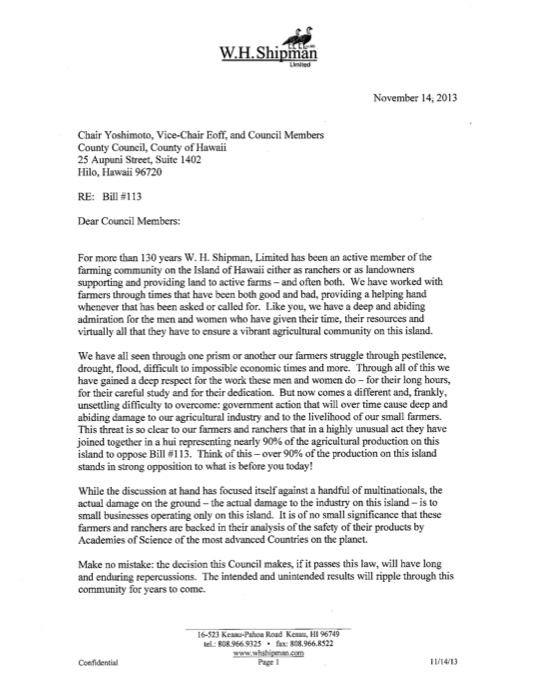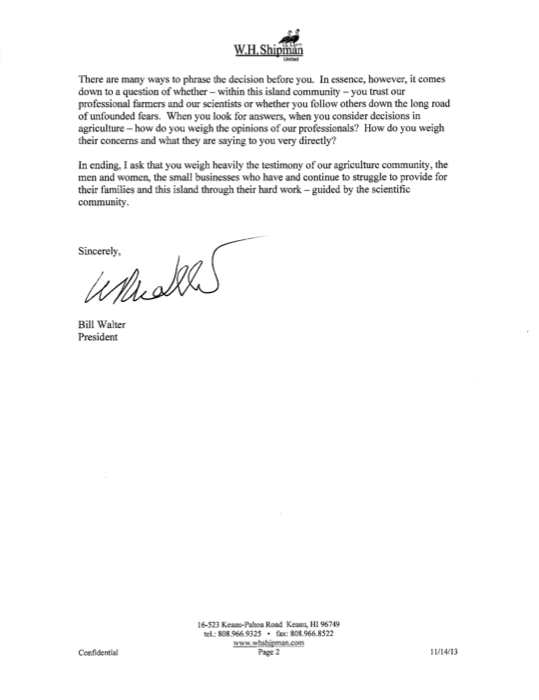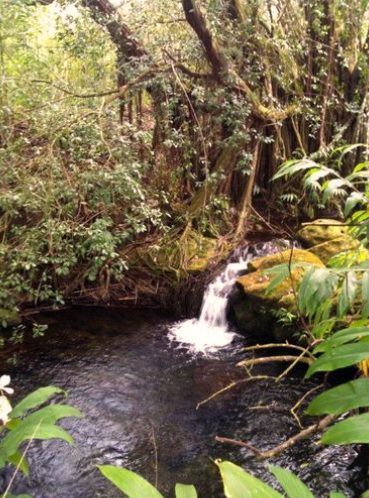Richard Ha writes:
Someone suggested that my change of plans re: putting 264 acres into preservation land smells of sour grapes – that I made a knee-jerk decision because I was upset that the anti-GMO Bill 113 passed.
But that’s not the way I make decisions. I am always looking five, 10 and 20 years ahead and planning what we need to do now to get where we need to be. Suddenly the future of farming on this island looked different, and I needed to be sure we have some flexibility at the farm.
Since I last wrote about this, though, I spoke with the USDA and found an option I didn’t previously know about. We can do a conservation easement that is less than the entire parcel. This will allow us to have a few small parcels that future generations could use for safety valve purposes, and still put land into the conservation easement. We will probably do this.
On Tuesday, the Hawai‘i County Council will decide whether to form an ad hoc committee of council members to analyze GMO issues and give the council recommendations for action. Otherwise, the mayor will do the analysis in-house.
It is no secret that I would have preferred for Mayor Kenoi to veto the anti-GMO Bill 113. But the reality is that the mayor did not have the votes to support a veto, and in this set of circumstances, I support the mayor over the council. He signed the bill, rather than wimping out and letting it pass without his signature. He was concerned about the rift in this community, and he assured the farmers that they would not get hurt.
And most of all, I know the Mayor is fact- and data-driven, something that is sorely missing from our current county council.
What I know about the county council is that its members have proven that they cannot separate fact from fiction, and therefore they are unqualified and unable to prepare us for the future.
In the recent Bill 113 debacle, our county council called Jeffrey Smith as its premier expert. This is an individual who has self-published two books about GMO foods but has zero scientific credentials and has been thoroughly debunked as any sort of credible GMO expert. He specializes in yogic flying (a kind of cross-legged hopping done in hopes of reducing crime and increasing “purity and harmony” in the “collective consciousness”). They allowed Smith to testify about GMOs for more than half an hour.
Three University of Hawai‘i experts on GMOs, on the other hand, were given a total of three minutes, between them, to testify. This averages out to one minute each.
If we are taking science into account, the Seralini study – which linked genetically modified maize and the herbicide RoundUp as having an increased cancer risk, and which was always widely pointed to as proving GMO foods were unsafe – was recently retracted by the scientific journal that published it, and rejected by the European Food Safety Authority (EFSA) for having serious defects and failing to meet scientific standards.
County Councilwoman Margaret Wille made a very inflammatory remark in a comment following a Honolulu Civil Beat article written by University of Hawai‘i professor Michael Shintaku. In her comment, she accused Professor Shintaku, as well as Dr. Susan Miyasaka and Dean Maria Gallo (also of the UH College of Tropical Agriculture), of being “unmistakeably caught in the predicament of becoming the mouthpiece for the GMO biotech industry that provides much of the funding for their employer.”
Michael Shintaku responded with a polite comment that detailed how she was incorrect. Many scientists voiced outrage at the inaccurate and flippant comment that impugned their integrity.
It seems, unfortunately, to be par for the course for some who are anti-science and anti-GMO. Have they made up their mind without regard to truth? Have they dug in their heels, refusing to ever even consider new evidence?
I haven’t. If suddenly there was real science that showed harm from GMOs, I would cross that off my list and move on to the next best solution that would help our island. To date, though, there has never been any such science, not anywhere.
Our county council clearly does not understand farming. Councilwoman Wille likes to show how many letters she has in favor of banning GMOs, but the smaller stack from people opposing the ban was from the farmers who produce more than 90 percent of the calories grown here on the Big Island.
Why is she listening to the gardeners and not the farmers? There is such a difference between gardening and farming. I compare it to cooking turkeys. Cooking one turkey is easy – you just turn the dial for the right time and temperature, and then poof! It’s perfect. Crispy on the outside and juicy on the inside. Cooking one turkey is similar to gardening.
Farming, on the other hand, is like cooking 20 turkeys an hour every hour. They cannot be burnt on the outside and raw on the inside. And they must be ready on time or your customers lose money. And every so often the power goes off or the house blows down and you have to start all over again. Farming is much more complicated than gardening.
Some anti-GMO people proclaim that we should all just eat organic. But have a look at Table 2 on page 19 of this Baseline Food Sustainability chart from the county.
Based on that table, we compared prices between a Kona supermarket and a Kona natural food store. The annual budget for a family of five at the Kona supermarket was approximately $20,000, while at the natural foods store it was slightly more than $42,000.
We did a similar comparison in Waimea, and the results were substantially the same. It is clear that most folks cannot afford organics.
Senator Ruderman, who owns a natural foods chain, claimed our price comparisons are wildly inaccurate, but they are not.
A few days ago, we learned that the Florida citrus industry, which has lost more than a million acres to citrus greening disease, may have found a GMO solution.
Although anti-GMO folks like to say they are on the side of farmers, if citrus greening disease makes it to the Big Island and we are not legally allowed to use the Florida GMO solution, it is only homeowners and small farmers who will be hurt.
Read this link for a sample of what some of the people who testified on the anti-GMO/County Council side of the argument were doing in the background. It is mean-spirited and it’s not who we in Hawai‘i are. There is no aloha in this.



